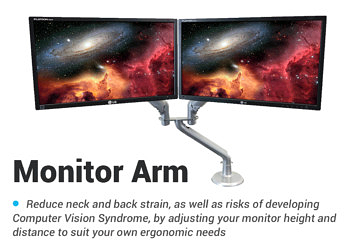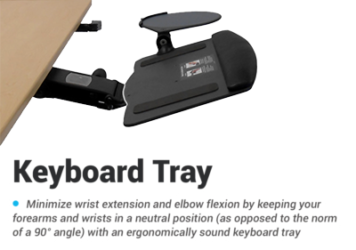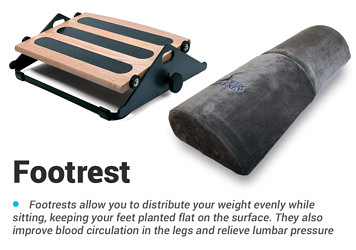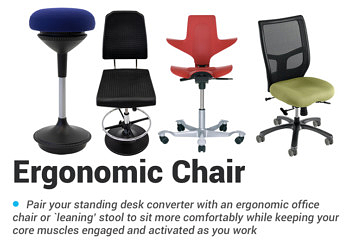iMovR Studio 470 Electric Standing Desk Base Review
- Lab tested
Like most reviews sites, our editorial staff and laboratory testing expenses are partially offset by earning small commissions (at no cost to you) when you purchase something through those links. Learn More

Overview
| Review Summary |
The Studio 470 was designed for one purpose: to make a high-quality yet inexpensive small-sized standing desk. Supremely lightweight design is easy to handle and perfectly suited to the compact footprint. It is not the base to place under a large, heavy desktop, or to be used with a lot of desktop equipment. If you’re looking to make a fast and simple compact standing desk for use with a laptop setup or minimal computer gear this new robotically-manufactured base gives cheap Chinese-made DIY frames a serious run for the money. |
|---|---|
| Best Use |
Compact standing desks |
| MSRP / List Price | $399 |
| Street Price | iMovR’s exclusive offer for WorkWhileWalking readers – Get 15% off everything in your cart with the coupon code WWW15 |
| Shipping |
Free |
| Warranty |
2 years on electronics |
| Lift Type |
Dual electric |
| Transit Speed |
1.25 inches per second |
| Controller |
Simple two-button up/down affair |
| Sizes Available |
Extensible frame works well for desktops up to 55″ wide |
| Colors Available |
Black, White and Silver |
| Construction |
Robotically-manufactured |
| Adjustment Range |
Height range: 26.85″-45.35″ |
| Weight Capacity |
176 lbs |
| Noise Level |
< 50 dB |
| Product Weight |
40 lbs |
| Typical Assembly Time |
30 minutes |
| ANSI/BIFMA Certified |
Yes |
| NEAT™ Certified by Mayo Clinic |
Yes |
| Competition |
DIY Standing Desk Frames Comparison Review
|
| Where to buy |
Buy on iMovR |
Rating
| Ease of Assembly | |
|---|---|
| Stability | |
| Reliability | |
| Customer Experience | |
| Quality and Aesthetics | |
| Innovation | |
| Value | |
| Positives | For the right application, a small desk footprint with an average-sized user, the Studio 470 is a bargain of a desk frame with superior quality to Chinese imports and an uncommonly easy build process. With this DIY base, you don't pay for what you don't need. |
| Negatives | Misses out on popular features like anti-collision detection, digital programmable handset with storable height favorites, bluetooth sync and smartphone apps, and other quality features you'll find on more premium-priced desks. The warranty is relatively short compared to iMovR's three other bases, which all have 10 year bumper-to-bumper coverage. |
Bottom Line

When it comes to building a DIY base there is a wide range of offerings along a wide spectrum of capabilities and budgets. At least as far as budget goes, pretty much every option is made in China. These include the Autonomous SmartDesk 2 DIY Standing Desk Base, StandDesk DIT Standup Desk Base Frame, and Jiecang Electric Standing Desk Base to name but a few that we’ve lab tested and reviewed. The basic philosophy with these products is to manufacture the simplest possible components for the user to spend their time putting together (the Autonomous comes with a bag of 48 bolts and screws, for example) thus reducing labor and shipping costs. See our primer on the differences between Chinese-made and American-made standing desk products.
Then there are the non-Chinese-made standalone bases, predominantly from the tech-forward leader in the office-fitness industry, iMovR. These bases include the Freedom (made in the USA with robotically made components from Lithuania), the Lander Lite (robotically made in Kentucky) and the Lander (robotically made in Kentucky). While these all cost a little more than the Chinese-made competitors they require less assembly effort of the user, are manufactured to much more precise tolerances, and come with substantially long warranties.
The iMovR Studio 470 DIY base literally sits in the middle between the ultra-cheap Chinese bases and the pricier, more technologically advanced non-Chinese frame kits. Since not everyone intends to build a desk with a capacious 36″ × 95″ top, most of the bases are actually overbuilt for the very common use case of someone who just needs a smaller desk, perhaps something in the range of 24″-deep by 35″-wide, or at least no larger than 31.5″-deep by 63″-wide. Anything more than that is “a waste of metal” and just increases production cost and the aggregate cost of shipping all through the supply chain until it reaches the end user.
The Sweet Spot for the Studio 470 Base

In our laboratory testing, we were impressed with the T-legged Studio 470 base for its intended application. We’ve seen other lightweight designs before but none that could pass ANSI/BIFMA testing like this one did. In fact, it has a raft of certifications not commonly found at all on Chinese-made standup desk frame kits.
While technically the base was certified for desktop sizes up to 31.5″ × 63″, in our experts’ estimation the maximum desktop size you’d want to plant atop this base is probably 30″ × 55″. The sweet spot is actually 48″ on the width, with the crossbars completely collapsed for maximum frame stability. Thus if you put anything larger on it we recommend keeping the crossbars at their minimum stretch (i.e. fully collapsed) and allowing the rest of the desktop to overhang a few inches on the left and right.
The weakest part of the frame is its crossbar, which is of such thin steel that it allows instability to be easily introduced into the desk when used at its upper height ranges. By not stretching the crossbars out, the rigidity of the frame is substantially improved. For bigger or heavier desktops one should definitely look to iMovR’s Freedom, Lander Lite or Lander Base, in that order of capability and price point.
The other dimension of a sweet spot is height range of the user. While iMovR makes bases for the very shortest and very tallest who walk amongst us (up to 56″ max height) the Studio 470’s single-stage base is decidedly pedestrian. It is designed with only an 18″ stroke (distance between minimum and maximum height) with the average height of an American user in the middle of the range. This compares to the 25″ stroke and 6″ leg extender option on most other iMovR DIY bases. The top-end height range is only going to be suitable for people under 5-foot-11 in height. While iMovR’s Freedom Base comes in three height ranges, the new Studio base only comes in one version, and it’s for middling-height users only.
When it comes to lift capacity the Studio 470 is rated to 176 pounds. Let’s be candid, that rating applies when all the weight on the desktop is well balanced. If all you’re planning to use is a laptop and perhaps a single monitor with an edge-clamped monitor arm, that should do fine. If you plan to use a heavy desktop, under-slung CPU, triple LCDs and a desktop printer, this is probably not the best base for that kind of heavy-duty application. This is where the stronger motors on iMovR’s other bases are really helpful in overcoming side-loading stresses on the lifting columns.
As desktop choices go we refer you to our comprehensive primer on Desktop Materials for Standing Desks as a starting point. For the Studio 470 base, we recommend going with a lighter choice . . . this is not the base for 1.5″-thick solid hickory. Note that iMovR plans to bring out a complete Studio Desk system in the future marrying the 470 base with an inch-thick powder-coated, ergo-contoured MDF desktop. That kind of top would go together with this base like an oaky chardonnay with creamy goat cheese. . . they were meant for each other.
What the Studio Base Doesn’t Have

According to the adage of “you get what you pay for and you pay for what you get” the Studio 470 base is bare-bones simplicity itself. No fancy digital controller with programmable memories – just an up/down button. No advanced controller features like anti-collision detection or Bluetooth interface and smartphone app.
But mostly it’s a matter of metal thickness. Heavier bases have a lower center of gravity and more frame rigidity. Most of that metal comes into play in wider desktop configurations where you can’t rely on the rigidity of the desktop alone (desktops with the most commonly used MDF cores have quite a bit of natural flex to them).
The advantage of using less metal has benefits, ranging from environmental (less extraction), production (easier to form), and most importantly shipping through the many stages from raw material to final product, and eventually shipping by FedEx to you. Fascinatingly, key components of the Studio 470 are actually manufactured in an end-to-end robotic factory in Lithuania, of all places. As factory reps described it, “raw material goes in one end and a boxed product comes out the other.”
As we’ve stated clearly above, the main limitation of this base is its focus on smaller/lighter desktop sizes and middling-range users. If that’s what you’re looking for you probably won’t find a better base for the money, anywhere.
Certifiably Good
The Swedish design team behind the linear actuators used in the Studio base tried to find a way of beating China at their own game by using precision robotics to compete with cheap labor, and they seem to have pulled it off. Despite its low cost and light weight the Studio base passed the certification testing for ANSI/BIFMA X5.5-2014, the gold standard for commercial contract-furniture vendors like Steelcase and Herman Miller, so it’s no slouch. While this desk does not meet the ANSI/BIFMA G1-2013 Ergonomic Guidelines because of its short stroke actuators, the meaningful test in terms of durability and reliability is the X5.5-2014 standard, which requires testing by an independent laboratory.
Not to bore the reader, but just for the record, the iMovR Studio 470 base has also been certificated for EN 527-2:2016 Office furniture – Work tables – Part 2: Safety, strength and durability requirements, and EN 1730 Furniture – Tables – Test methods for the determination of stability, strength and durability. The paint/surface of the stand is approved according to standard: EN 12720:2009+A1:2013 Furniture – Assessment of surface resistance to cold liquids and EN 15186:2012 Furniture – Assessment of the surface resistance to scratching. The electronics are certified according to RoHs, Reach, EMC directive, UL962 and CHINA RoHS. That’s robust!
Easy Assembly
See the video to get an excellent sense of what it’s like to buy a standing desk using the Studio 470 base. It’s a bit easier than most bases because the design minimizes the use of too many parts or screws holding things together, and they’re much lighter to move around. In comparing to bases like the Jiecang or Autonomous, the Studio requires less than half the number of screws and bolts. The assembly instructions are very thorough and easy to understand.
If you’re an experienced desk assembler with all the right power tools expect about a 30-minute assembly process, and if it’s your first time putting one together, set aside 45 minutes. All-in-all, it should take you about half the time to assemble a Studio 470 base as a conventional Chinese-made alternative.
The Takeaway

If all you’re looking to build is a small 2′ × 4′ or 30″ × 53″ desk, and you don’t care about the frills, the Studio 470 is an excellent choice because you won’t be paying for anything you won’t need. With robotically-built components globally sourced and final-assembled in the USA, the Studio 470 is iMovR’s answer to the cheaply-made, budget bases from China. At $399, it’s a hands-down winner in this category.
Our bottom line, though, is that this is a light-duty base that wants to go with a small, lightweight top and balanced weight distribution on the work surface. Whereas iMovR’s three other state-of-the-art bases carry longer warranties, the Studio 470’s warranty is only two years on electronics, five years on moving parts and 10 years on the steel frame.
Like all iMovR bases, however, it does feature the same 100-day satisfaction guarantee, which means you can return it with only a 20-percent restocking fee (if in new condition, obviously) if for any reason you decide it’s not the right base for your workstation. That said, the parameters for when this would be the right base to use are well spelled out by iMovR. Still not sure? Hit them up in live chat at iMovR.com and ask one of their DIY product experts.
No other standing desk manufacturer offers as many models of DIY bases as iMovR does — most competitors offer only one or two, not four distinct models — so these folks really know their stuff. Their team is well practiced at guiding newbie DIYers on their mission to build the perfect standing desk for themselves.
Compare the Studio 470 to all other options in our primer on Choosing the Right Electric Base for Your DIY Standing Desk.





0 Comments
Leave a response >